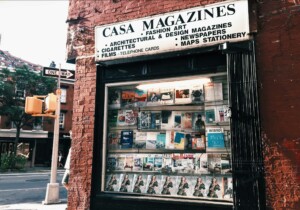This is an excerpt from an interview held at William Stout Architectural Books on December 13, 2022, with Bill Stout and Erik Heywood, for the Architects Newspaper article, “Torch Passed: The Eames Institute’s acquisition of William Stout’s bookstore preserves a cultural icon.” Bill Stout is the founder of the bookstore that the Eames Institute acquired in October 2022. Erik Heywood, Retail Director of the Eames Institute, has been managing the store since the acquisition. He is also the founder of the Oakland-based Book/Shop. As both their lives have been devoted to books, Elizabeth Snowden asked for their take on the present state—and future—of print.
Bill Stout (BS): Most people in tech think print is dead, but it is never going to be dead. Some of the best books ever done have been done in the last ten years—out of Europe. The U.S. is really backward when it comes to taking care of the culture—to me that is what is interesting about the Eames Institute. Whereas in Switzerland, the government subsidizes books, here you would call that commie, but it proves a very important part of having an institutional bookstore like this.
Erik Heywood (EH): I would invite anyone who thinks print is dead or dying to come in here [to William Stout Architectural Books] on a Saturday. We all keep pretty busy for being dead. In my experience, the people who say print is going away don’t read. They are just repeating something they heard being said, or they are selling a device so they have an interest in saying “Nah, it’s all going to be digital.”
BS: And what do you do with a digital library if you can’t afford the digital program?
EH: People talk about tech making things really democratic. It’s not, because you have to keep buying devices and upgraded devices. That is the thing about books; they are one and done. In the 1950s, Lawrence Clark Powell, the head librarian at UCLA, said to his library science majors, “A book is for all people in all places for all time.” Microfiche and film were coming in then, and they were saying, “That’s the end of books.” “These are not going to do in books,” Powell said. And it has never been truer than now. People come into a room full of books and go “ahhhh.” It is just the presence, being surrounded by them that they love.
BS: In the mid-90s there was a lot of anticipation about it being worse than it was. The small bookstores that didn’t mark down their books lost a lot of clients, and then we lost them because the American publishers were so eager to get in bed with Amazon. Publishers don’t have to discount their books. The reason bookstores do so well in Europe is they are not discounted on Amazon for the first two years.
EH: it is true that as Bill goes through the history of the shop with me and the numbers, it is not and never will be what it was 20 years ago.
BS: It is a different mentality. I think what is interesting is that it still exists at all and can work.
EH: What gives value to a bookstore like this now is that it is edited. It has architecture and design, and there are some other things, but a big part of why a bookstore like this gets to keep being around is because it’s specific.
BS: Architectural monographs, industrial design, and theory are the core of Stout Books, but we carry a lot of other types too, art, dance, landscape, etc., because at one time we had 200 libraries buying from us. We did a regular catalog with as many as a thousand books. The librarians would get one, have it on their desks, mark it up, and send it back. But that changed in the mid-90s.
EH: Bookstores are not rational; they are labors of love. Any bookstore is a reflection of the person who owns it—they are very personal—and they have to stay that way in order to work or resonate.
BS: All you have to do is go to the local museum and see how they have screwed everything up. They only carry what will sell and if it doesn’t sell it’s out of there. The Metropolitan and maybe a few others carry books that really define what they are about. That is why I have always wanted history and theory.
EH: When you look at the ascendant years of Stout books, it really was that paper architecture glory days in the ’80s and ’90s and the idea of architecture and the limitless possibilities, if you let it be limitless. That is a great spirit to keep on here.
BS: But the attitude of the ’70s and ’80s has changed a lot now. There seemed to be a lot of creative writing at that period. You had the Institute in New York; you had John Parman doing Design Book Review; you had Andrew and Mark doing Arch Type; Limn furniture was just starting down the street; and there was ARCH. There was a lot of activity in the ’80s that filtered out, and there is a different attitude about that now. Every school had an architectural magazine. The most important one was Perspecta out of Yale, which was basically Stern when he was in school.
EH: When you ask yourself how many architecture and design bookstores there are in the U.S., there is Peter Miller, there is us, and there is Hennessy + Ingalls. New York doesn’t even have one anymore, nor do other cities you would expect, like Chicago. We feel like there is space for there to be at least one in the world.











